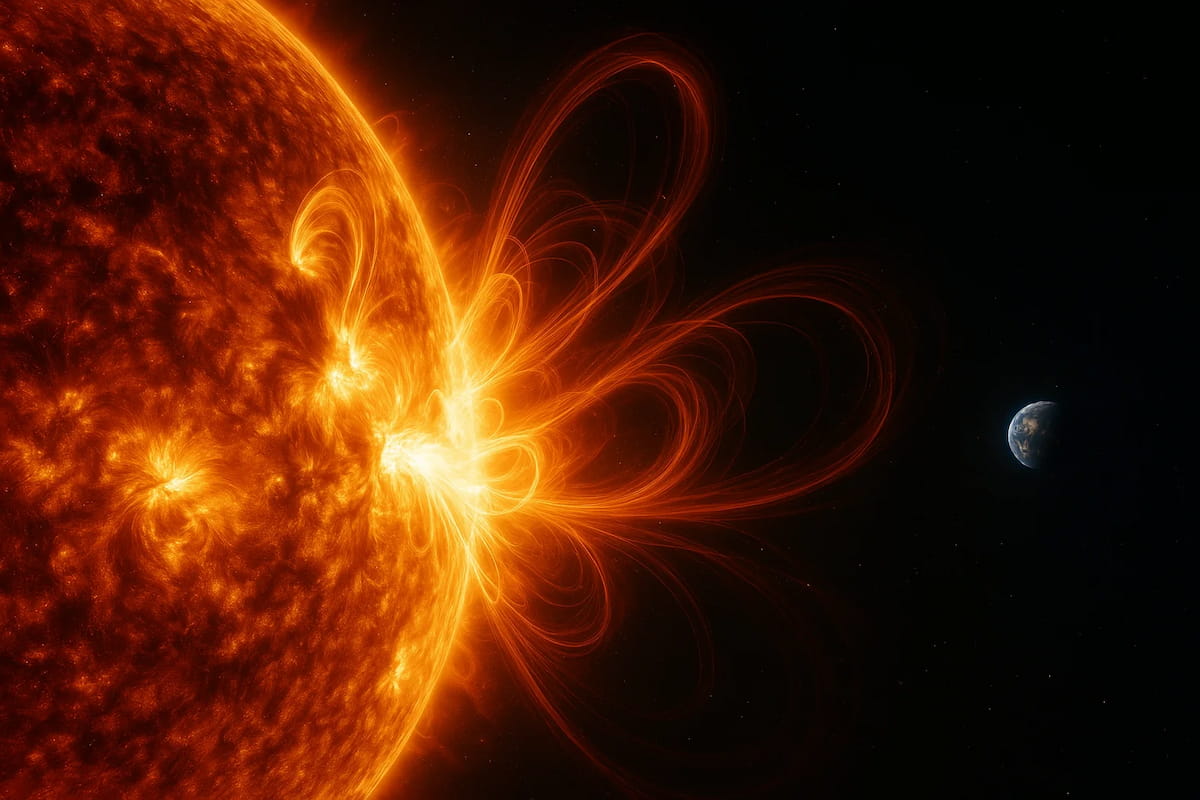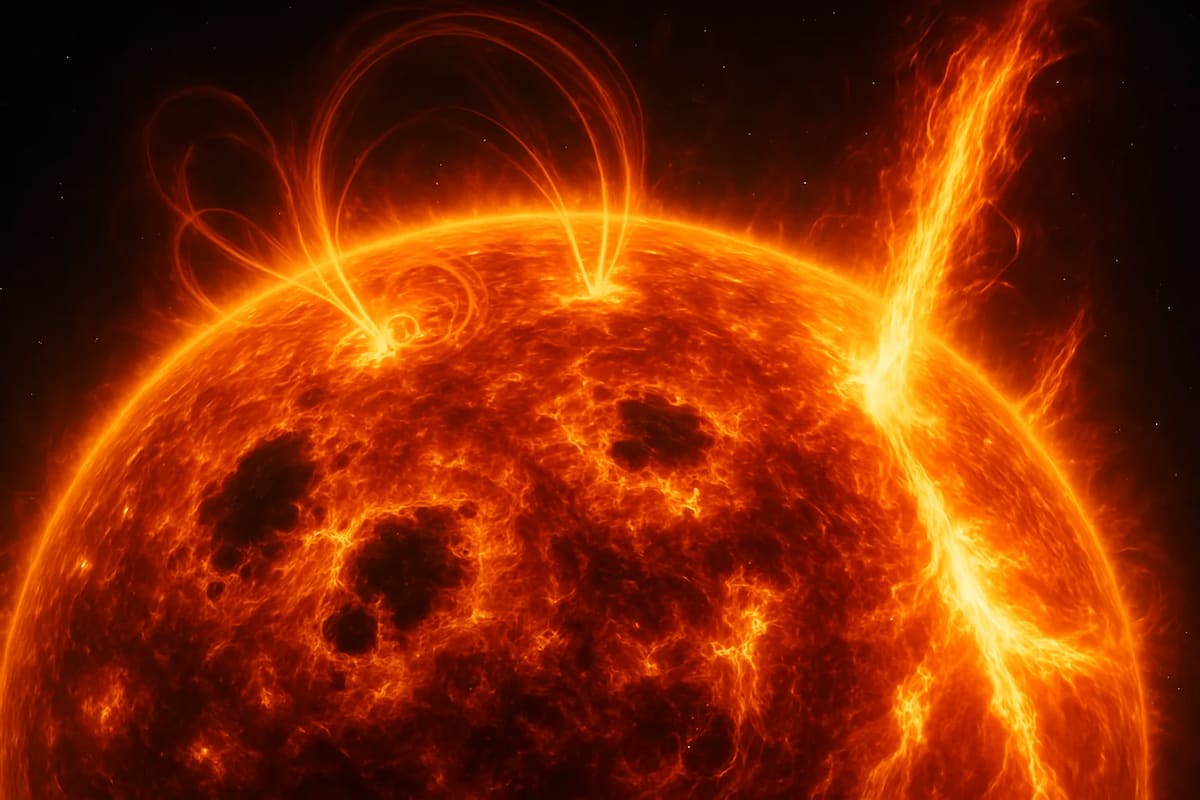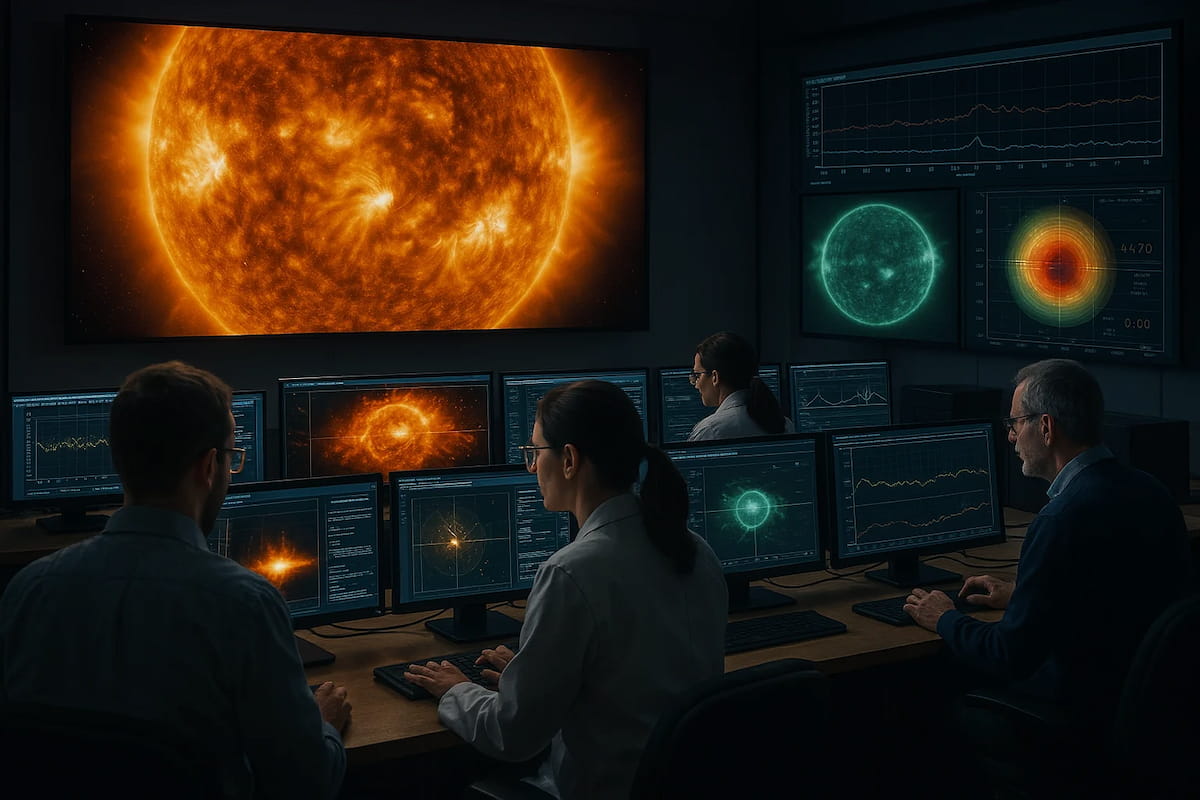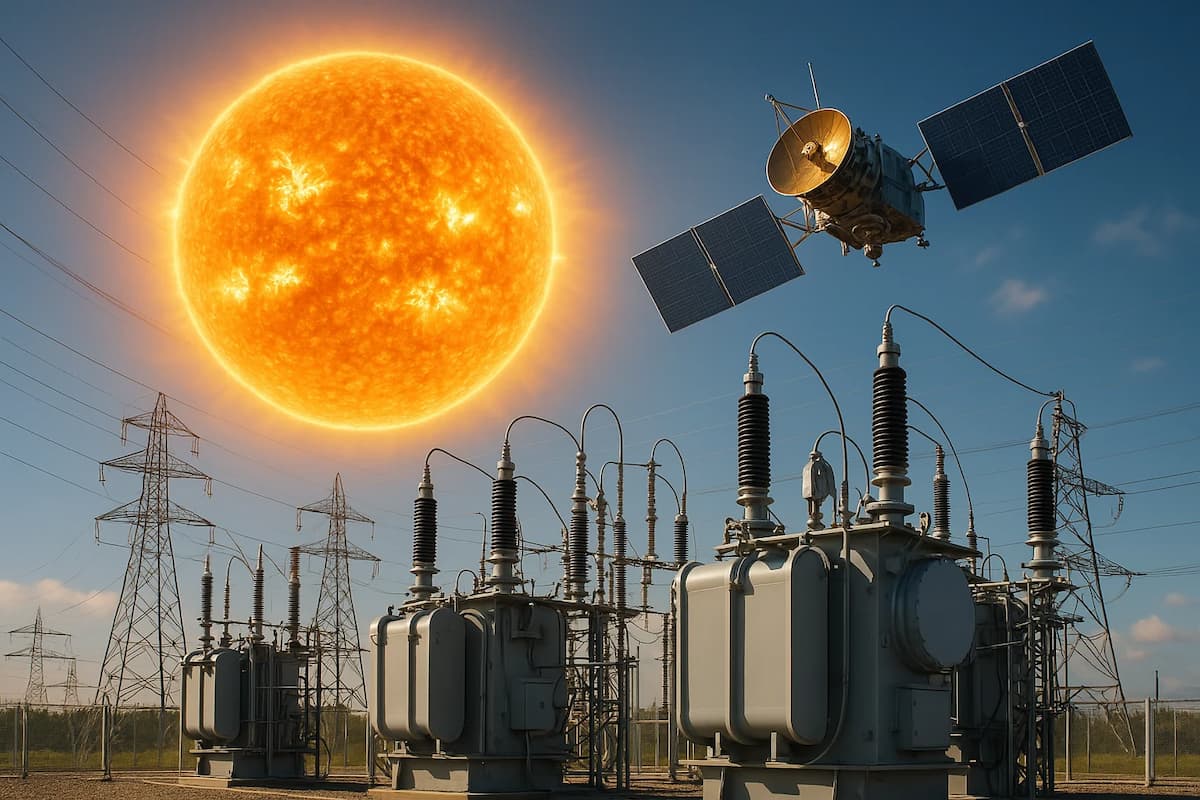
Watch short for this article (5 slides)
Beyond the Blue Sky: Understanding Solar Flares and Their Impact on Earth
The serene expanse above often belies the dynamic and sometimes tumultuous environment of space. Beyond Earth's protective atmosphere, colossal cosmic events unfold, driven primarily by our own star, the Sun. Among the most dramatic of these are solar flares - immense bursts of energy that can significantly influence our planet, affecting technologies we rely on daily and even posing potential risks. What triggers these solar eruptions, how exactly do they interact with Earth, and what practical measures can mitigate their effects? Let's explore the science behind solar flares and space weather.
Decoding Solar Flares: Eruptions from Our Star
A solar flare is a sudden, intense brightening observed on the Sun's surface, representing a massive release of energy. These events originate in magnetically complex regions known as active regions, often associated with sunspots (cooler, dark patches on the photosphere).
The Mechanics: Magnetic Reconnection Unleashed
The Sun's magnetic field is incredibly dynamic. Imagine complex loops and lines of magnetic force extending from the surface out into the corona (the Sun's outer atmosphere). These field lines can become highly stressed, twisted, and tangled due to the Sun's differential rotation (rotating faster at the equator than the poles) and convective motions.
When these stressed magnetic field lines abruptly reconfigure into a simpler, lower-energy state - a process called magnetic reconnection - enormous amounts of stored magnetic energy are suddenly converted into kinetic energy, heat, and particle acceleration. This powers the flare.
- Electromagnetic Radiation: Flares release radiation across the entire electromagnetic spectrum, from radio waves to gamma rays, with particularly strong emissions in X-rays and ultraviolet (UV) light. This radiation travels at the speed of light, reaching Earth in approximately 8 minutes.
- Accelerated Particles: Flares accelerate charged particles (primarily protons and electrons) to near-relativistic speeds. These Solar Energetic Particles (SEPs) can arrive at Earth minutes to hours after the flare's light.
- Coronal Mass Ejections (CMEs): Often, though not always, associated with large flares are CMEs. These are colossal eruptions releasing billions of tons of plasma (ionized gas) and embedded magnetic fields from the Sun's corona into space. CMEs travel much slower than flare radiation, typically taking 1 to 4 days to reach Earth, depending on their speed (ranging from 250 km/s to over 3000 km/s).

Flare Classification: Gauging the Intensity
Solar flares are classified based on their X-ray brightness as measured by satellites like the GOES (Geostationary Operational Environmental Satellite) series. The classes range from weakest to strongest:
- A, B, C: Small flares, common, usually have little to no effect on Earth.
- M-class: Medium-sized flares. Can cause brief radio blackouts affecting Earth's polar regions and minor radiation storms.
- X-class: Major flares. Can trigger planet-wide radio blackouts, long-lasting radiation storms potentially harmful to astronauts and satellites, and are often associated with strong CMEs.
Within each class, there's a linear scale from 1 to 9 (e.g., M1, M9, X1, X9). Flares stronger than X9 are possible (e.g., X10, X20). (Source: NOAA/SWPC - Solar Flares)
Earthly Impacts: When Solar Events Reach Our World
While Earth's magnetic field (magnetosphere) and atmosphere shield us from the worst effects, strong solar events can still have significant consequences.
Geomagnetic Storms: Earth's Magnetic Field Disturbed
The primary driver of significant space weather impacts on Earth is the arrival of a CME or a high-speed stream of solar wind interacting with our magnetosphere. This interaction transfers energy and momentum, causing large-scale disturbances known as geomagnetic storms.
- Auroras (Northern and Southern Lights): During storms, energized particles precipitate down magnetic field lines into the upper atmosphere near the poles. They collide with atmospheric gases (oxygen and nitrogen), exciting them and causing them to glow, creating spectacular auroral displays. Strong storms can push auroras to much lower latitudes than usual.

- Power Grid Disruptions (GICs): Rapid changes in Earth's magnetic field during a storm induce electrical currents in long conductors on the ground, such as power lines and pipelines. These Geomagnetically Induced Currents (GICs) can flow into high-voltage transformers, causing them to saturate, overheat, and potentially fail, leading to widespread blackouts. The severity depends on the storm intensity, grid topology, and geological conductivity. (Source: NOAA/SWPC - Geomagnetic Storms)
- Satellite Operations: Satellites face multiple threats:
- Surface Charging: Low-energy particles can build up static charge on satellite surfaces, leading to damaging electrical discharges (arcing).
- Deep Dielectric Charging: High-energy electrons can penetrate satellite shielding and embed within internal components (cables, circuit boards), potentially causing malfunctions or failures days later.
- Increased Drag: Geomagnetic storms heat the upper atmosphere (thermosphere), causing it to expand. This increases atmospheric density at satellite altitudes (especially Low Earth Orbit - LEO), increasing drag, altering orbits, and potentially shortening satellite lifespans.
- Single Event Upsets (SEUs): High-energy particles (SEPs) can flip bits in satellite memory or cause processor errors, disrupting operations.
- Communication Disruptions:
- Radio Blackouts (HF): Intense X-ray emissions from flares ionize the D-layer of Earth's ionosphere on the dayside, absorbing High Frequency (HF) radio waves (3-30 MHz) used for long-distance communication (e.g., aviation, maritime, emergency services). This effect occurs almost instantly with the flare.
- Satellite Communications (Scintillation): Irregularities in the ionosphere during geomagnetic storms can distort or block satellite signals (like GPS and satellite TV/radio), particularly at higher latitudes.
- GPS Navigation Errors: Solar flares and geomagnetic storms alter the density of the ionosphere, changing the speed at which GPS signals travel through it. This introduces positioning errors that can range from a few meters to tens of meters, impacting precision applications like surveying, agriculture, and aviation navigation.
Radiation Hazards
- Astronauts: Astronauts outside the protection of the magnetosphere (e.g., on lunar missions) or even in Earth orbit (like on the ISS) face increased radiation exposure from SEPs during major solar events, potentially exceeding safety limits without adequate shielding or operational changes (like moving to heavily shielded modules).
- Air Travel: Passengers and crew on high-latitude, high-altitude flights can receive increased radiation doses during strong SEP events. Flight paths are sometimes rerouted during severe solar radiation storms. (Source: NOAA/SWPC - Solar Radiation Storms)
Debated Impacts on Human Health (Ground Level)
While the radiation risks for astronauts and air travelers are well-established, claims of direct, significant health effects on the general population at ground level from solar flares or geomagnetic storms are highly controversial and lack robust scientific consensus. Earth's atmosphere and magnetosphere provide very effective shielding. Some studies have explored potential correlations between geomagnetic activity and cardiovascular events, mood changes, or exacerbation of certain conditions, but establishing causality is extremely difficult due to numerous confounding factors. Current authoritative health organizations do not recognize geomagnetic storms as a direct significant health hazard for people on the ground. (Source: CDC Radiation Emergencies - context on radiation types and effects - Note: Focuses on ionizing radiation in general, not specifically linking ground-level GMS to health issues).
Landmark Solar Events and Their Lessons
The Carrington Event (1859)
Considered the most powerful geomagnetic storm on record, triggered by a massive flare and CME. Auroras were seen as far south as the Caribbean and Hawaii. The primary technology of the day, the telegraph system, experienced widespread disruptions; operators received shocks, sparks flew from equipment, and some lines continued functioning even after being disconnected from power sources due to induced currents.
"A Carrington-level event today would have catastrophic consequences for our technologically dependent society, potentially causing trillions of dollars in damage and requiring months or years for full recovery of power grids and satellite infrastructure." - Conclusion from various scientific risk assessments. (Source: NASA - Carrington Event context)
The Quebec Blackout (March 1989)
A severe geomagnetic storm induced powerful GICs that overwhelmed the Hydro-Québec power grid. Protective relays tripped cascades, causing a province-wide blackout affecting six million people for up to nine hours. This event highlighted the vulnerability of modern power grids, especially those at high latitudes or with long transmission lines, and spurred significant investment in understanding and mitigating GIC risks.
Forecasting the Fury: Space Weather Prediction
Predicting solar flares themselves remains challenging, similar to predicting earthquakes. However, monitoring solar activity and forecasting the arrival and potential impact of CMEs is an active area of research and operations.
- Solar Observatories: Ground-based telescopes and space-based missions like NASA's Solar Dynamics Observatory (SDO), the Solar and Heliospheric Observatory (SOHO - NASA/ESA), and Parker Solar Probe constantly monitor the Sun's surface magnetic fields, active regions, coronal structure, and eruptive events.
- Monitoring Agencies: Organizations like NOAA's Space Weather Prediction Center (SWPC) in the US and similar centers worldwide analyze data 24/7. They issue watches, warnings, and alerts for solar flares, radiation storms, and geomagnetic storms.
- Prediction Capabilities: Once a CME is observed leaving the Sun, models can estimate its trajectory and arrival time at Earth (typically with uncertainties of several hours). Forecasts use scales like the Kp-index (planetary geomagnetic activity) or the G-scale (geomagnetic storm intensity from G1-minor to G5-extreme) to communicate potential impacts.
Mitigation and Preparedness: Living with a Star
While we cannot control the Sun, society and individuals can take steps to reduce vulnerability.
Societal-Level Mitigation
- Power Grid Hardening: Utilities implement operational procedures (like adjusting load flows, temporarily taking equipment offline), install GIC blocking devices or monitoring equipment, and improve grid design to withstand geomagnetic disturbances.
- Satellite Design and Operation: Building more radiation-hardened components, implementing effective shielding, designing systems tolerant to SEUs, and adjusting satellite operations (e.g., powering down sensitive instruments) during predicted storms.
- Improved Forecasting: Continued investment in research, monitoring missions (like placing upstream solar wind monitors at the L1 Lagrange point), and predictive modeling to provide more accurate and timely warnings.

Individual Preparedness
While large-scale impacts require infrastructure solutions, individuals can take practical steps:
- Protect Electronics:
- Surge Protectors: Offer protection against common voltage spikes from the *internal* power grid but provide little to no protection against GICs, which are low-frequency, quasi-DC currents.
- Uninterruptible Power Supply (UPS): A battery backup UPS can protect sensitive electronics (computers, network equipment) from sudden power outages caused by grid disruptions and provide some level of power conditioning.
- Disconnecting Devices: During warnings of potentially severe geomagnetic storms, unplugging non-essential electronics can offer protection from grid surges or fluctuations, although this is primarily relevant in the case of grid failure rather than direct GIC damage to home appliances.
- Backup Critical Data: Regularly back up important digital files (photos, documents, financial records) to multiple locations (e.g., external hard drive, secure cloud storage) to prevent data loss due to power issues or hardware failure.
- Stay Informed: Check space weather forecasts occasionally, especially if planning activities sensitive to disruptions (like aviation, amateur radio, or relying heavily on GPS precision). Reputable sources include:
- NOAA Space Weather Prediction Center (SWPC)
- SpaceWeatherLive app or similar reputable sources.
- Emergency Preparedness Basics: Having basic emergency supplies (water, food, flashlight, batteries, first-aid kit) is always prudent for any potential disruption, including power outages potentially triggered by space weather.
Note: Linking individual climate actions (renewable energy, consumption) directly to mitigating solar flare impacts is scientifically tenuous. While environmental stewardship is crucial for planetary health, the mechanisms of solar flare generation and their interaction with Earth are independent of terrestrial climate change drivers like CO₂ emissions. Focusing preparedness on direct technological and informational aspects is more relevant.
Conclusion: Navigating Our Cosmic Neighborhood
Solar flares and CMEs are potent demonstrations of the Sun's power and a natural part of living within a star system. While often harmless, major events pose real risks to our increasingly technology-reliant civilization, capable of disrupting power grids, disabling satellites, impairing communications, and increasing radiation exposure in space and at high altitudes. We cannot prevent these solar storms, but through continued scientific understanding, advanced monitoring, robust engineering of critical infrastructure, and sensible individual preparedness, we can better anticipate and mitigate their impacts. Recognizing our connection to the wider cosmos and the dynamic nature of our star is the first step toward building resilience for the inevitable celestial weather ahead.